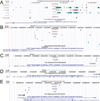Insertional hypermutation in mineral oil-induced plasmacytomas
- PMID: 24975032
- PMCID: PMC4165787
- DOI: 10.1002/eji.201344322
Insertional hypermutation in mineral oil-induced plasmacytomas
Abstract
Unless stimulated by a chronic inflammatory agent, such as mineral oil, plasma cell tumors are rare in young BALB/c mice. This raises the questions: What do inflammatory tissues provide to promote mutagenesis? And what is the nature of mutagenesis? We determined that mineral oil-induced plasmacytomas produce large amounts of endogenous retroelements--ecotropic and polytropic murine leukemia virus and intracisternal A particles. Therefore, plasmacytoma formation might occur, in part, by de novo insertion of these retroelements, induced or helped by the inflammation. We recovered up to ten de novo insertions in a single plasmacytoma, mostly in genes with common retroviral integration sites. Additional integrations accompany tumor evolution from a solid tumor through several generations in cell culture. The high frequency of de novo integrations into cancer genes suggests that endogenous retroelements are coresponsible for plasmacytoma formation and progression in BALB/c mice.
Keywords: Endogenous retroelements; Inflammation; Mutagenesis; Plasmacytomas; Tumor evolution.
© 2014 WILEY-VCH Verlag GmbH & Co. KGaA, Weinheim.
Figures













Similar articles
-
Experimental plasmacytoma in mice. I. Induction, morphological and biological characteristics.Arch Immunol Ther Exp (Warsz). 1980;28(1):167-72. Arch Immunol Ther Exp (Warsz). 1980. PMID: 7416920
-
Experimental plasmacytomas in relation to human multiple myeloma.Ann Clin Lab Sci. 1974 May-Jun;4(3):157-63. Ann Clin Lab Sci. 1974. PMID: 4825619 No abstract available.
-
Chromosomal alteration and development of tumors. XIX. Chromosome constitution of tumor cells in 16 plasma cell neoplasms of BALB-c mice.J Natl Cancer Inst. 1968 Nov;41(5):1083-97. J Natl Cancer Inst. 1968. PMID: 4176942 No abstract available.
-
Growth of primary plasmacytomas in the mineral oil-conditioned peritoneal environment.J Natl Cancer Inst. 1972 Jul;49(1):305-8. J Natl Cancer Inst. 1972. PMID: 5037438 No abstract available.
-
Plasmacytomagenesis in mice: model of neoplastic development dependent upon chromosomal translocations.Carcinogenesis. 1992 Oct;13(10):1681-97. doi: 10.1093/carcin/13.10.1681. Carcinogenesis. 1992. PMID: 1423827 Review.
Cited by
-
Inbred Mouse Models in Cryptococcus neoformans Research.J Fungi (Basel). 2024 Jun 17;10(6):426. doi: 10.3390/jof10060426. J Fungi (Basel). 2024. PMID: 38921412 Free PMC article. Review.
-
Infectivity and insertional mutagenesis of endogenous retrovirus in autoimmune NZB and B/W mice.J Gen Virol. 2015 Nov;96(11):3396-3410. doi: 10.1099/jgv.0.000271. Epub 2015 Aug 26. J Gen Virol. 2015. PMID: 26315139 Free PMC article.
-
Complement C3d enables cell-mediated immunity capable of distinguishing spontaneously transformed from nontransformed cells.Proc Natl Acad Sci U S A. 2024 Dec 24;121(52):e2405824121. doi: 10.1073/pnas.2405824121. Epub 2024 Dec 18. Proc Natl Acad Sci U S A. 2024. PMID: 39693340 Free PMC article.
-
Antigen-mediated regulation in monoclonal gammopathies and myeloma.JCI Insight. 2018 Apr 19;3(8):e98259. doi: 10.1172/jci.insight.98259. eCollection 2018 Apr 19. JCI Insight. 2018. PMID: 29669929 Free PMC article. Clinical Trial.
References
-
- Potter M, Wiener F. Plasmacytomagenesis in mice: model of neoplastic development dependent upon chromosomal translocations. Carcinogenesis. 1992;13:1681–1697. - PubMed
-
- Potter M. The early history of plasma cell tumors in mice, 1954–1976. Adv Cancer Res. 2007;98:17–51. - PubMed
-
- Potter M, Maccardle RC. Histology of Developing Plasma Cell Neoplasia Induced by Mineral Oil in Balb/C Mice. J Natl Cancer Inst. 1964;33:497–515. - PubMed
Publication types
MeSH terms
Substances
Grants and funding
LinkOut - more resources
Full Text Sources
Other Literature Sources

